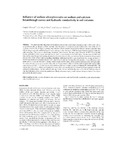Influence of sodium adsorption ratio on sodium and calcium breakthrough curves and saturated hydraulic conductivity in soil columns.
Date
2007Author
Dikinya, O.
Hinz, C.
Aylmore, L.G.
Publisher
Csiro, http://www.publish.csiro.au/nid/84.htmType
Published ArticleMetadata
Show full item recordAbstract
The paper examines the effects of electrolyte concentration and sodium adsorption ration (SAR) on the relative saturated hydraulic conductivity (RHC) and the ionic behaviour of calcium (Ca) and sodium (Na) ions in the Na-Ca echange complex. Batch binary exchange and saturated column transport experiments were carried out to quantify these effects using agricultural Balkuling soil and mining residue. Generally, RHC has been found to decrease with time, with increasing SAR and with decreasing electrolyte concentration. The more rapid decrease in RHC in the mining residue, particularly at the lowest concentration (1 mmol/L), was consistent at all SAR values. The decreases in RHC were likely to be caused by partial blocking of pores by dispersed clay particles, as evidenced by the appearance of suspended clay particles in the effluent during leaching. Significant differences in RHC were abserved in the passage of fronts of decreasing electrolyte concentration for CaCl2 and SAR 15 solutions through the soil columns. These differences were attributable to structural alterations (slaking) of the media and the nature of the particles released and mobilised within the porous structure at a given point in the column. Measurements at the critical threshold concentration and turbidity increase in SAR to 15 is initially accompained by erractic RHC, presumably due to the break up of soilaggregates under the increased swelling forces. The less coherent mining residue soil was substantially more vulnerable to blockage of pores than the Balkuling soil in which clay particles are likely to be more readily mobilised, and hence available to re-deposit and occlude the matrix pores.

